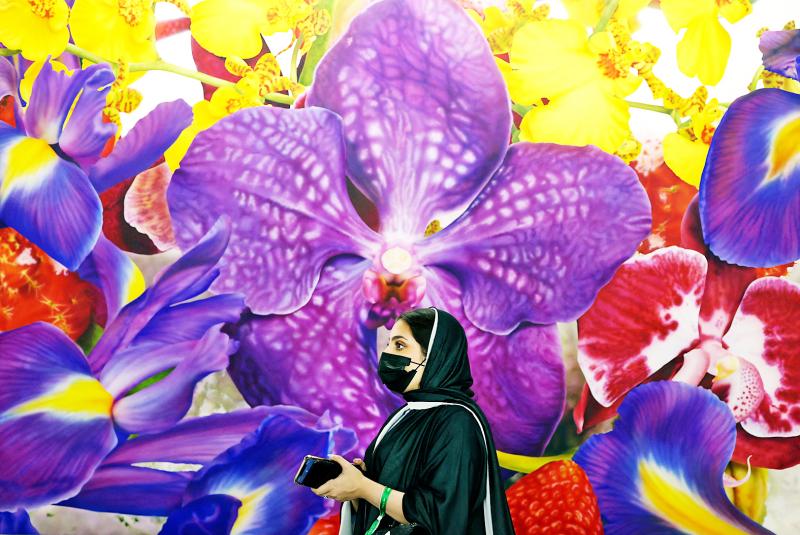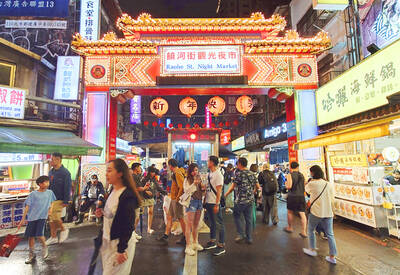Art Dubai, the Middle East’s largest annual contemporary art fair, has featured for the first time digital works, as the wealthy Gulf emirate seeks to position itself as a crypto assets hub.
This year, in its 15th edition, the four-day fair is hosting more than 100 local and foreign art dealers, with an entire wing of 17 galleries and platforms dedicated to showcasing and selling non-fungible tokens (NFTs).
NFT sales platforms use the blockchain technology behind cryptocurrencies and transform anything from illustrations to memes into virtual collectors’ items that cannot be duplicated.

Photo: AFP
NFTs, which burst into the mainstream last year and are now traded at major auction houses, have drawn a lot of attention in the United Arab Emirates, already a leisure and trading hub, Art Dubai executive director Benedetta Ghione said.
The increased interest, along with Dubai’s “unique position” as “a growing crypto hub,” prompted fair organizers to dedicate a new digital section, she said at the launch on Friday. “We thought this was the perfect time and the perfect place,” she said.
After signing an agreement in December last year with Binance (幣安), the world’s largest cryptocurrency exchange by trading volume, Dubai — one of the seven emirates that make up the United Arab Emirates (UAE) — last week introduced a new virtual assets law and a regulatory authority to oversee the sector.
Dubai ruler Sheikh Mohammed bin Rashid al-Maktoum wrote on Twitter that such a step “establishes the UAE’s position in this sector” and aims “to ensure maximum transparency and security for investors.”
Local NFT platforms have welcomed the move as good for business, with crypto holders increasingly interested in digital art as a form of investment.
“The crypto community is growing exponentially,” said Jennifer Stelco, cofounder of NFT curatorial platform Morrow Collective, which exhibited about 20 digital artworks at the show, nearly all of them by UAE-based artists.
Among them is a piece by Vesa, a renowned Finnish mixed-media artist based in Dubai, whose artwork combining painting and digitally retouched images went on offer for 50 ethereum (US$2,590.40).
Stelco said that one piece by Lebanese artist Magda Malkoun, whose main work depicted her hometown Beirut as a strong female, was sold for 3 ethereum.
The global NFT boom, with US artist Beeple selling an artwork at a record-breaking US$69 million last year, has encouraged the Middle East’s first online platform, Emergeast, to turn to digital art. Established in 2014 and dedicated to emerging artists from the region, Emergeast sees NFTs as an opportunity for artists to “really expand” their audiences, reaching collectors and non-collectors, cofounder Nikki Meftah said.
“The benefit also is that all the artists get royalties for every sale,” she added.
Faced with the NFT hype, Emirati sculptor and painter Aisha Juma started reworking some sketches on a tablet a few months ago, although she stresses the importance of the art’s message over its medium.
“There is complexity, because now people are interested in the medium ... in the technology,” she said. “The technology is extremely valuable. It gives me a platform to express more and to use more tools, I am not denying that, but I would also love people to look at the art, at what I am saying.”

Among the rows of vibrators, rubber torsos and leather harnesses at a Chinese sex toys exhibition in Shanghai this weekend, the beginnings of an artificial intelligence (AI)-driven shift in the industry quietly pulsed. China manufactures about 70 percent of the world’s sex toys, most of it the “hardware” on display at the fair — whether that be technicolor tentacled dildos or hyper-realistic personalized silicone dolls. Yet smart toys have been rising in popularity for some time. Many major European and US brands already offer tech-enhanced products that can enable long-distance love, monitor well-being and even bring people one step closer to

Malaysia’s leader yesterday announced plans to build a massive semiconductor design park, aiming to boost the Southeast Asian nation’s role in the global chip industry. A prominent player in the semiconductor industry for decades, Malaysia accounts for an estimated 13 percent of global back-end manufacturing, according to German tech giant Bosch. Now it wants to go beyond production and emerge as a chip design powerhouse too, Malaysian Prime Minister Anwar Ibrahim said. “I am pleased to announce the largest IC (integrated circuit) Design Park in Southeast Asia, that will house world-class anchor tenants and collaborate with global companies such as Arm [Holdings PLC],”

Sales in the retail, and food and beverage sectors last month continued to rise, increasing 0.7 percent and 13.6 percent respectively from a year earlier, setting record highs for the month of March, the Ministry of Economic Affairs said yesterday. Sales in the wholesale sector also grew last month by 4.6 annually, mainly due to the business opportunities for emerging applications related to artificial intelligence (AI) and high-performance computing technologies, the ministry said in a report. The ministry forecast that retail, and food and beverage sales this month would retain their growth momentum as the former would benefit from Tomb Sweeping Day

TRANSFORMATION: Taiwan is now home to the largest Google hardware research and development center outside of the US, thanks to the nation’s economic policies President Tsai Ing-wen (蔡英文) yesterday attended an event marking the opening of Google’s second hardware research and development (R&D) office in Taiwan, which was held at New Taipei City’s Banciao District (板橋). This signals Taiwan’s transformation into the world’s largest Google hardware research and development center outside of the US, validating the nation’s economic policy in the past eight years, she said. The “five plus two” innovative industries policy, “six core strategic industries” initiative and infrastructure projects have grown the national industry and established resilient supply chains that withstood the COVID-19 pandemic, Tsai said. Taiwan has improved investment conditions of the domestic economy